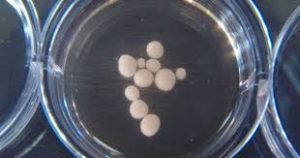Lab-Grown Minibrains:

Minibrains grown in the lab may help explain why concussions and other traumatic brain injuries (TBIs) raise people’s risk of dementia.
- Lab-grown minibrains are scientifically known as brain organoids, but often called “minibrains” and serve as miniature, simplified models of full-size human brains.
- Scientists typically grow brain organoids from stem cells, a type of immature cell that can give rise to any cell type, whether blood, skin, bowel or brain.
- The stem cells used to grow organoids can either come from adult human cells or more rarely, human embryonic tissue.
- Scientists collect adult cells and then expose them to chemicals in order to revert them into a stem cell-like state.
- The resulting stem cells are called “induced pluripotent stem cells” (iPSC), which can be made to grow into any kind of tissue.
- To give rise to a minibrain, scientists embed these stem cells in a protein-rich matrix, a substance that supports the cells as they divide and form a 3D shape. Alternatively, the cells may be grown atop a physical, 3D scaffold.
- These organoids can potentially be useful in basic research, drug development and even computer science.




